560 Business Communication: Class Act Ltd. Case Study Analysis
VerifiedAdded on 2023/05/28
|11
|2410
|420
Case Study
AI Summary
This case study analyzes the communication issues faced by Class Act Ltd, a private training organization in Kerikeri. The report evaluates the impact of the company's communication policy on organizational performance, identifies unethical practices related to diversity and inclusion, and examines the current communication culture. Key issues include miscommunication, lack of diversity, and delayed responses. The analysis highlights the potential negative effects on employee retention, student enrollment, and overall revenue. Recommendations are provided to improve communication clarity, implement a quality management policy, foster a better communication culture through internal mechanisms, and develop ethical practices to mitigate misbehavior and ill-treatment within the organization. The goal is to promote positive communication and enhance organizational performance.
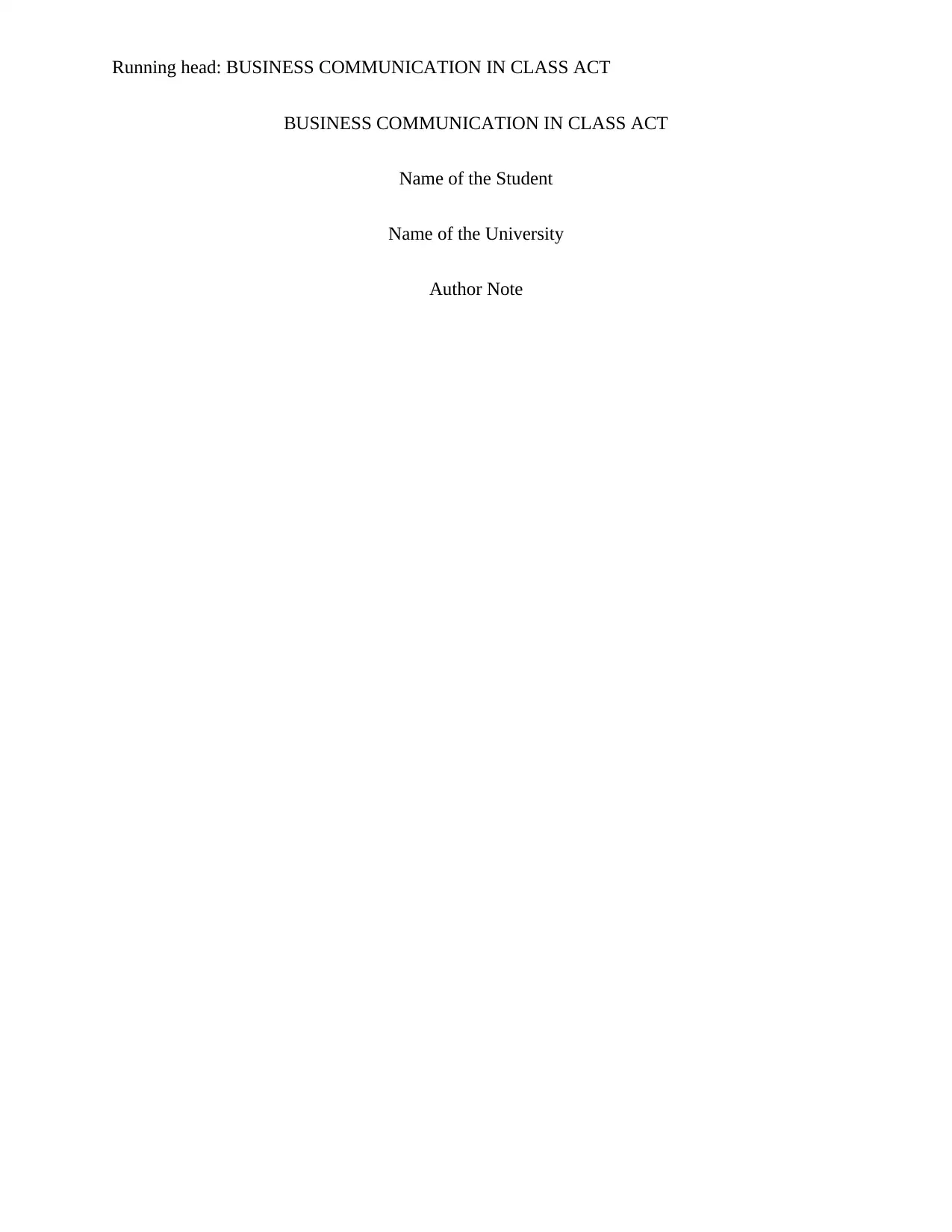
Running head: BUSINESS COMMUNICATION IN CLASS ACT
BUSINESS COMMUNICATION IN CLASS ACT
Name of the Student
Name of the University
Author Note
BUSINESS COMMUNICATION IN CLASS ACT
Name of the Student
Name of the University
Author Note
Paraphrase This Document
Need a fresh take? Get an instant paraphrase of this document with our AI Paraphraser
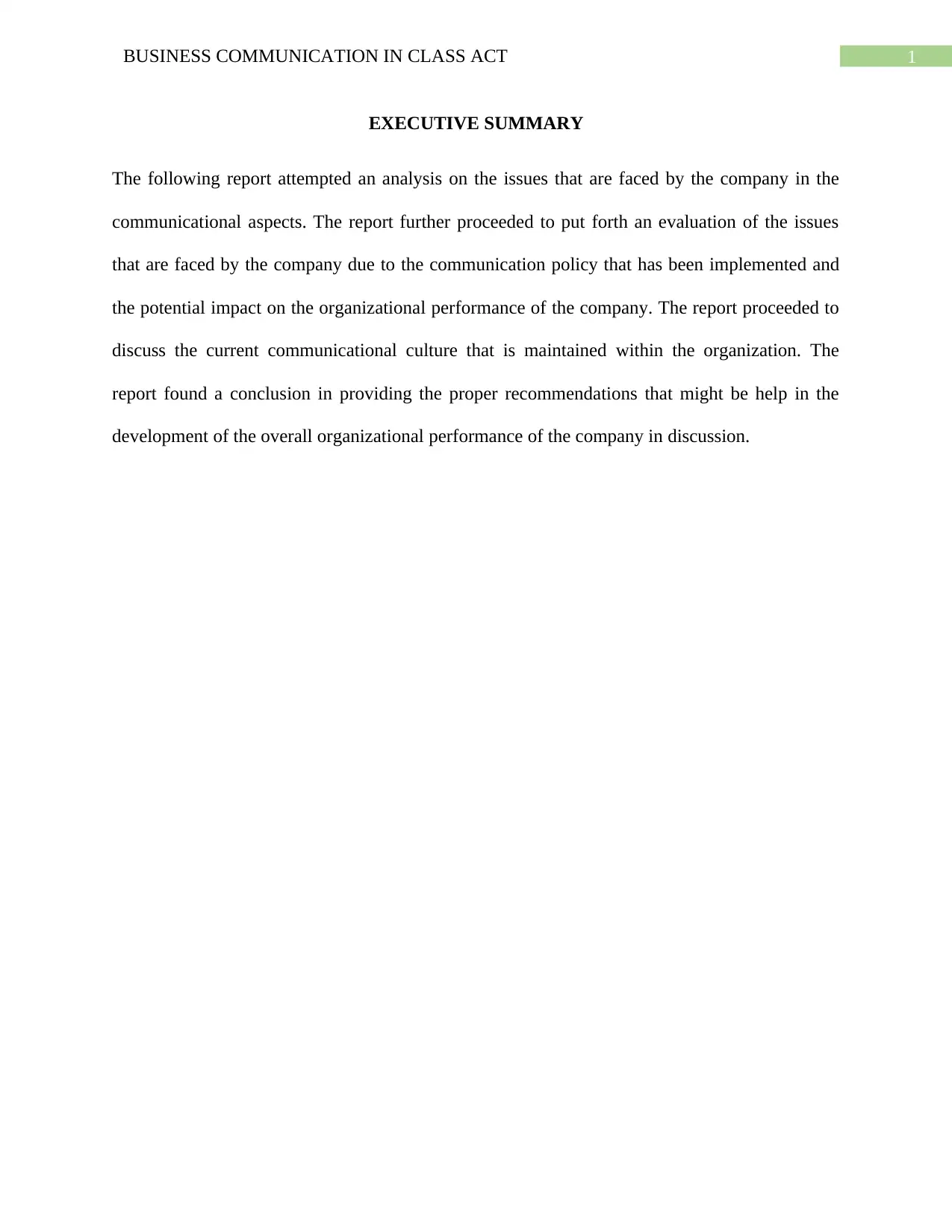
1BUSINESS COMMUNICATION IN CLASS ACT
EXECUTIVE SUMMARY
The following report attempted an analysis on the issues that are faced by the company in the
communicational aspects. The report further proceeded to put forth an evaluation of the issues
that are faced by the company due to the communication policy that has been implemented and
the potential impact on the organizational performance of the company. The report proceeded to
discuss the current communicational culture that is maintained within the organization. The
report found a conclusion in providing the proper recommendations that might be help in the
development of the overall organizational performance of the company in discussion.
EXECUTIVE SUMMARY
The following report attempted an analysis on the issues that are faced by the company in the
communicational aspects. The report further proceeded to put forth an evaluation of the issues
that are faced by the company due to the communication policy that has been implemented and
the potential impact on the organizational performance of the company. The report proceeded to
discuss the current communicational culture that is maintained within the organization. The
report found a conclusion in providing the proper recommendations that might be help in the
development of the overall organizational performance of the company in discussion.
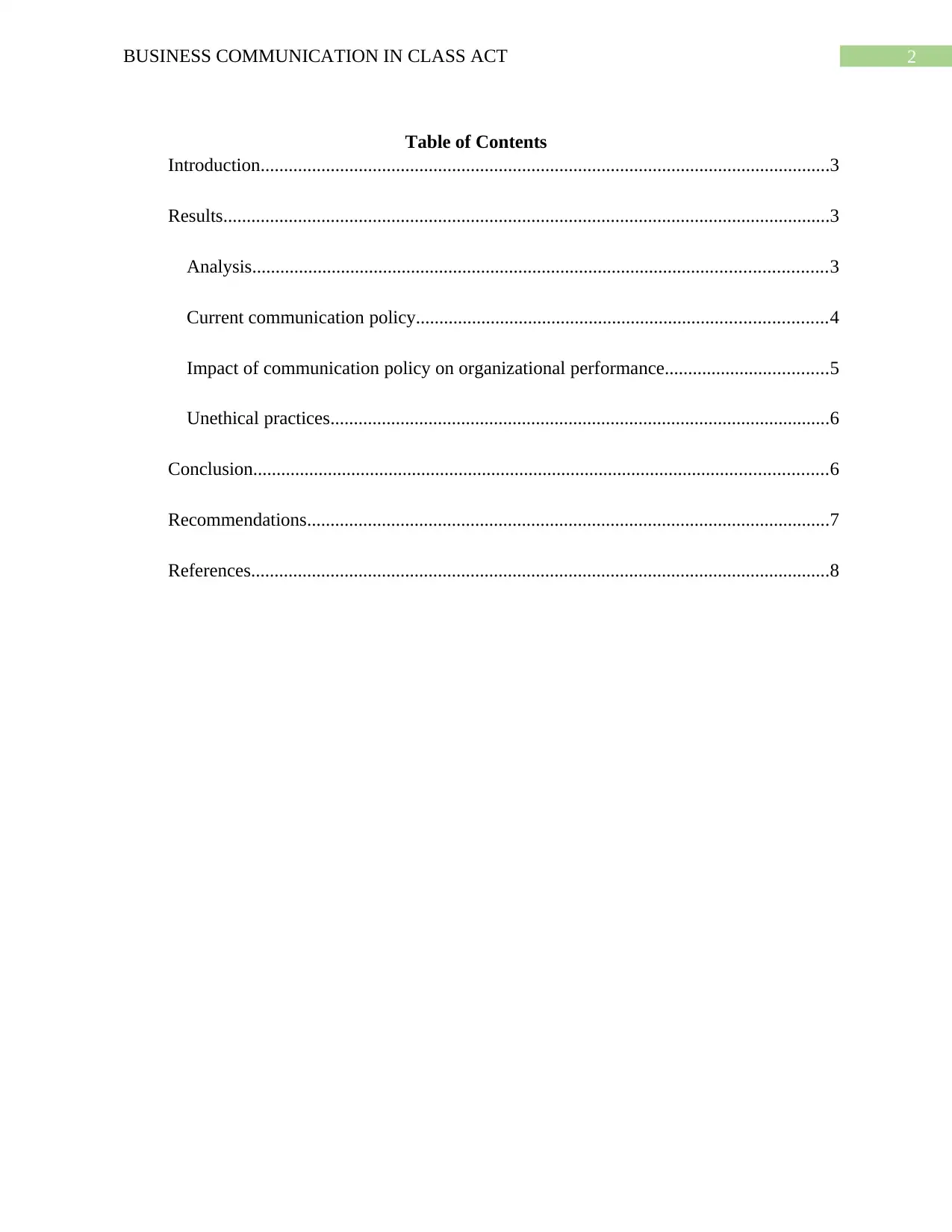
2BUSINESS COMMUNICATION IN CLASS ACT
Table of Contents
Introduction..........................................................................................................................3
Results..................................................................................................................................3
Analysis...........................................................................................................................3
Current communication policy........................................................................................4
Impact of communication policy on organizational performance...................................5
Unethical practices...........................................................................................................6
Conclusion...........................................................................................................................6
Recommendations................................................................................................................7
References............................................................................................................................8
Table of Contents
Introduction..........................................................................................................................3
Results..................................................................................................................................3
Analysis...........................................................................................................................3
Current communication policy........................................................................................4
Impact of communication policy on organizational performance...................................5
Unethical practices...........................................................................................................6
Conclusion...........................................................................................................................6
Recommendations................................................................................................................7
References............................................................................................................................8
⊘ This is a preview!⊘
Do you want full access?
Subscribe today to unlock all pages.

Trusted by 1+ million students worldwide
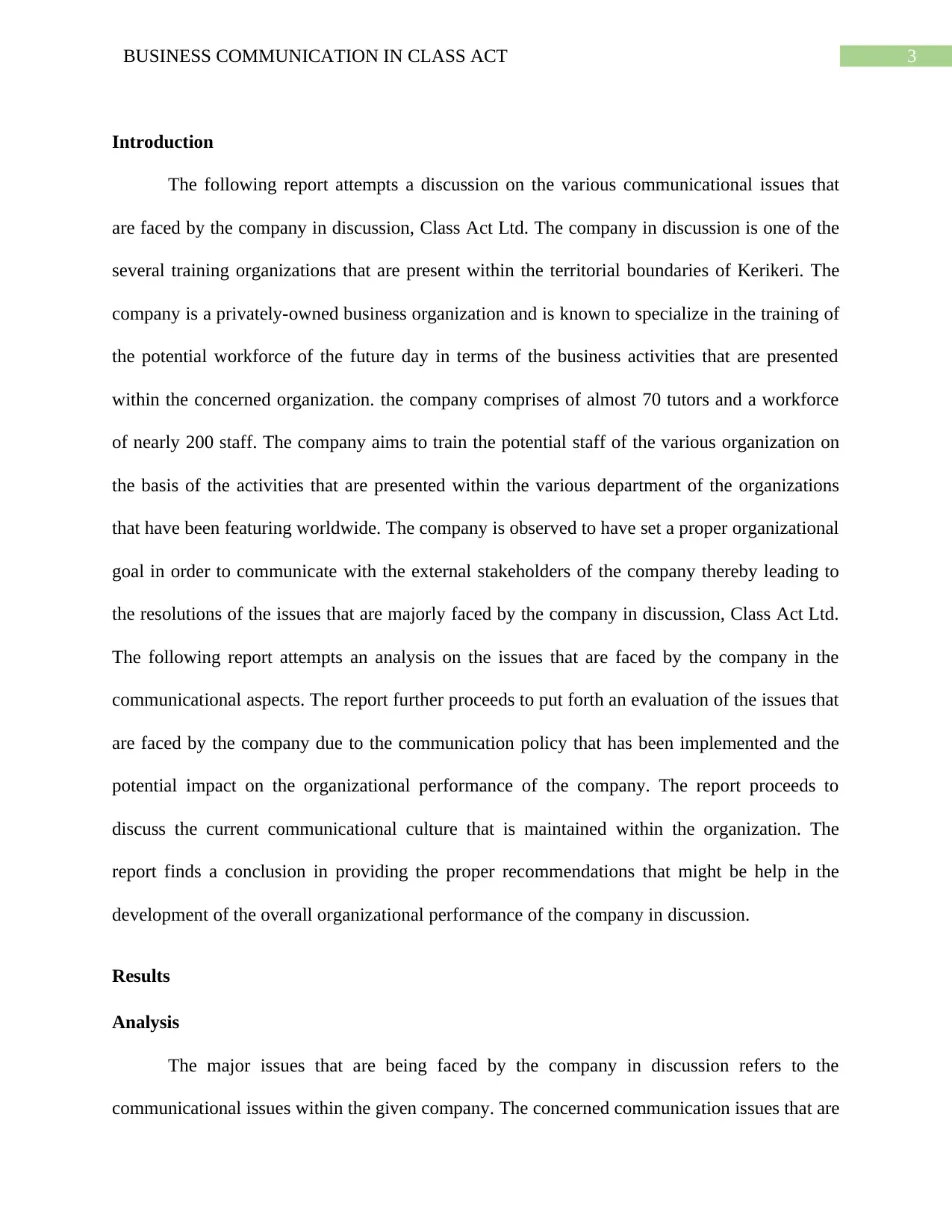
3BUSINESS COMMUNICATION IN CLASS ACT
Introduction
The following report attempts a discussion on the various communicational issues that
are faced by the company in discussion, Class Act Ltd. The company in discussion is one of the
several training organizations that are present within the territorial boundaries of Kerikeri. The
company is a privately-owned business organization and is known to specialize in the training of
the potential workforce of the future day in terms of the business activities that are presented
within the concerned organization. the company comprises of almost 70 tutors and a workforce
of nearly 200 staff. The company aims to train the potential staff of the various organization on
the basis of the activities that are presented within the various department of the organizations
that have been featuring worldwide. The company is observed to have set a proper organizational
goal in order to communicate with the external stakeholders of the company thereby leading to
the resolutions of the issues that are majorly faced by the company in discussion, Class Act Ltd.
The following report attempts an analysis on the issues that are faced by the company in the
communicational aspects. The report further proceeds to put forth an evaluation of the issues that
are faced by the company due to the communication policy that has been implemented and the
potential impact on the organizational performance of the company. The report proceeds to
discuss the current communicational culture that is maintained within the organization. The
report finds a conclusion in providing the proper recommendations that might be help in the
development of the overall organizational performance of the company in discussion.
Results
Analysis
The major issues that are being faced by the company in discussion refers to the
communicational issues within the given company. The concerned communication issues that are
Introduction
The following report attempts a discussion on the various communicational issues that
are faced by the company in discussion, Class Act Ltd. The company in discussion is one of the
several training organizations that are present within the territorial boundaries of Kerikeri. The
company is a privately-owned business organization and is known to specialize in the training of
the potential workforce of the future day in terms of the business activities that are presented
within the concerned organization. the company comprises of almost 70 tutors and a workforce
of nearly 200 staff. The company aims to train the potential staff of the various organization on
the basis of the activities that are presented within the various department of the organizations
that have been featuring worldwide. The company is observed to have set a proper organizational
goal in order to communicate with the external stakeholders of the company thereby leading to
the resolutions of the issues that are majorly faced by the company in discussion, Class Act Ltd.
The following report attempts an analysis on the issues that are faced by the company in the
communicational aspects. The report further proceeds to put forth an evaluation of the issues that
are faced by the company due to the communication policy that has been implemented and the
potential impact on the organizational performance of the company. The report proceeds to
discuss the current communicational culture that is maintained within the organization. The
report finds a conclusion in providing the proper recommendations that might be help in the
development of the overall organizational performance of the company in discussion.
Results
Analysis
The major issues that are being faced by the company in discussion refers to the
communicational issues within the given company. The concerned communication issues that are
Paraphrase This Document
Need a fresh take? Get an instant paraphrase of this document with our AI Paraphraser
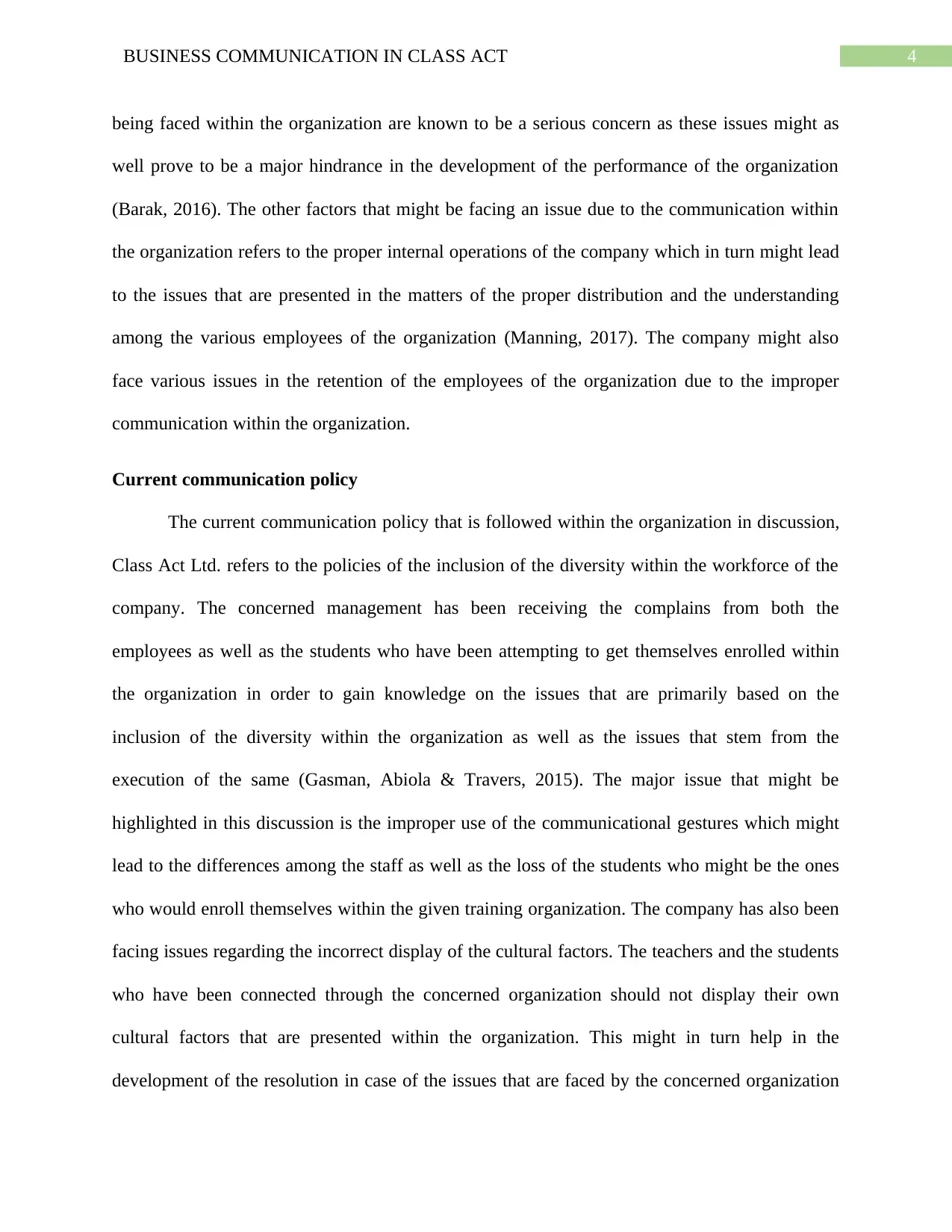
4BUSINESS COMMUNICATION IN CLASS ACT
being faced within the organization are known to be a serious concern as these issues might as
well prove to be a major hindrance in the development of the performance of the organization
(Barak, 2016). The other factors that might be facing an issue due to the communication within
the organization refers to the proper internal operations of the company which in turn might lead
to the issues that are presented in the matters of the proper distribution and the understanding
among the various employees of the organization (Manning, 2017). The company might also
face various issues in the retention of the employees of the organization due to the improper
communication within the organization.
Current communication policy
The current communication policy that is followed within the organization in discussion,
Class Act Ltd. refers to the policies of the inclusion of the diversity within the workforce of the
company. The concerned management has been receiving the complains from both the
employees as well as the students who have been attempting to get themselves enrolled within
the organization in order to gain knowledge on the issues that are primarily based on the
inclusion of the diversity within the organization as well as the issues that stem from the
execution of the same (Gasman, Abiola & Travers, 2015). The major issue that might be
highlighted in this discussion is the improper use of the communicational gestures which might
lead to the differences among the staff as well as the loss of the students who might be the ones
who would enroll themselves within the given training organization. The company has also been
facing issues regarding the incorrect display of the cultural factors. The teachers and the students
who have been connected through the concerned organization should not display their own
cultural factors that are presented within the organization. This might in turn help in the
development of the resolution in case of the issues that are faced by the concerned organization
being faced within the organization are known to be a serious concern as these issues might as
well prove to be a major hindrance in the development of the performance of the organization
(Barak, 2016). The other factors that might be facing an issue due to the communication within
the organization refers to the proper internal operations of the company which in turn might lead
to the issues that are presented in the matters of the proper distribution and the understanding
among the various employees of the organization (Manning, 2017). The company might also
face various issues in the retention of the employees of the organization due to the improper
communication within the organization.
Current communication policy
The current communication policy that is followed within the organization in discussion,
Class Act Ltd. refers to the policies of the inclusion of the diversity within the workforce of the
company. The concerned management has been receiving the complains from both the
employees as well as the students who have been attempting to get themselves enrolled within
the organization in order to gain knowledge on the issues that are primarily based on the
inclusion of the diversity within the organization as well as the issues that stem from the
execution of the same (Gasman, Abiola & Travers, 2015). The major issue that might be
highlighted in this discussion is the improper use of the communicational gestures which might
lead to the differences among the staff as well as the loss of the students who might be the ones
who would enroll themselves within the given training organization. The company has also been
facing issues regarding the incorrect display of the cultural factors. The teachers and the students
who have been connected through the concerned organization should not display their own
cultural factors that are presented within the organization. This might in turn help in the
development of the resolution in case of the issues that are faced by the concerned organization
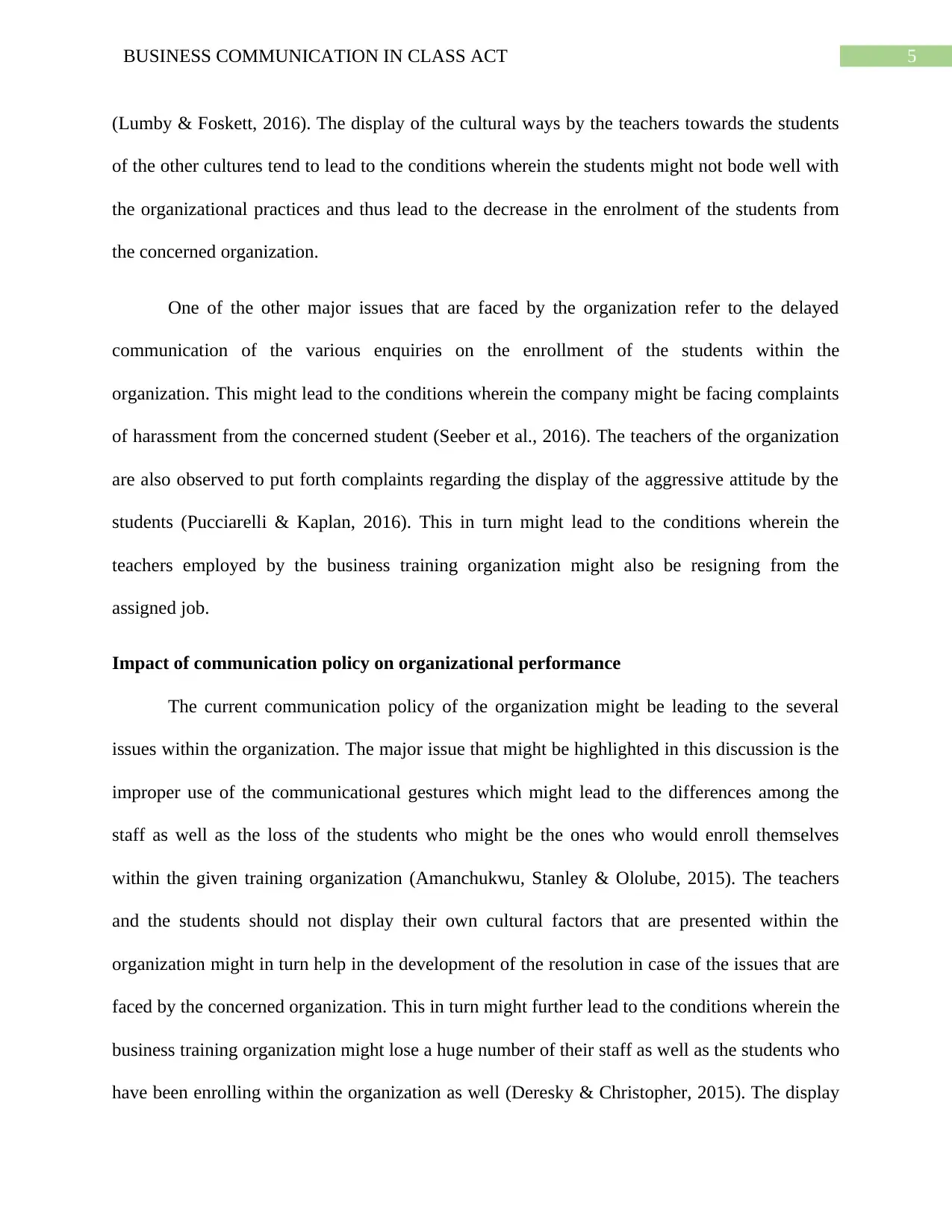
5BUSINESS COMMUNICATION IN CLASS ACT
(Lumby & Foskett, 2016). The display of the cultural ways by the teachers towards the students
of the other cultures tend to lead to the conditions wherein the students might not bode well with
the organizational practices and thus lead to the decrease in the enrolment of the students from
the concerned organization.
One of the other major issues that are faced by the organization refer to the delayed
communication of the various enquiries on the enrollment of the students within the
organization. This might lead to the conditions wherein the company might be facing complaints
of harassment from the concerned student (Seeber et al., 2016). The teachers of the organization
are also observed to put forth complaints regarding the display of the aggressive attitude by the
students (Pucciarelli & Kaplan, 2016). This in turn might lead to the conditions wherein the
teachers employed by the business training organization might also be resigning from the
assigned job.
Impact of communication policy on organizational performance
The current communication policy of the organization might be leading to the several
issues within the organization. The major issue that might be highlighted in this discussion is the
improper use of the communicational gestures which might lead to the differences among the
staff as well as the loss of the students who might be the ones who would enroll themselves
within the given training organization (Amanchukwu, Stanley & Ololube, 2015). The teachers
and the students should not display their own cultural factors that are presented within the
organization might in turn help in the development of the resolution in case of the issues that are
faced by the concerned organization. This in turn might further lead to the conditions wherein the
business training organization might lose a huge number of their staff as well as the students who
have been enrolling within the organization as well (Deresky & Christopher, 2015). The display
(Lumby & Foskett, 2016). The display of the cultural ways by the teachers towards the students
of the other cultures tend to lead to the conditions wherein the students might not bode well with
the organizational practices and thus lead to the decrease in the enrolment of the students from
the concerned organization.
One of the other major issues that are faced by the organization refer to the delayed
communication of the various enquiries on the enrollment of the students within the
organization. This might lead to the conditions wherein the company might be facing complaints
of harassment from the concerned student (Seeber et al., 2016). The teachers of the organization
are also observed to put forth complaints regarding the display of the aggressive attitude by the
students (Pucciarelli & Kaplan, 2016). This in turn might lead to the conditions wherein the
teachers employed by the business training organization might also be resigning from the
assigned job.
Impact of communication policy on organizational performance
The current communication policy of the organization might be leading to the several
issues within the organization. The major issue that might be highlighted in this discussion is the
improper use of the communicational gestures which might lead to the differences among the
staff as well as the loss of the students who might be the ones who would enroll themselves
within the given training organization (Amanchukwu, Stanley & Ololube, 2015). The teachers
and the students should not display their own cultural factors that are presented within the
organization might in turn help in the development of the resolution in case of the issues that are
faced by the concerned organization. This in turn might further lead to the conditions wherein the
business training organization might lose a huge number of their staff as well as the students who
have been enrolling within the organization as well (Deresky & Christopher, 2015). The display
⊘ This is a preview!⊘
Do you want full access?
Subscribe today to unlock all pages.

Trusted by 1+ million students worldwide
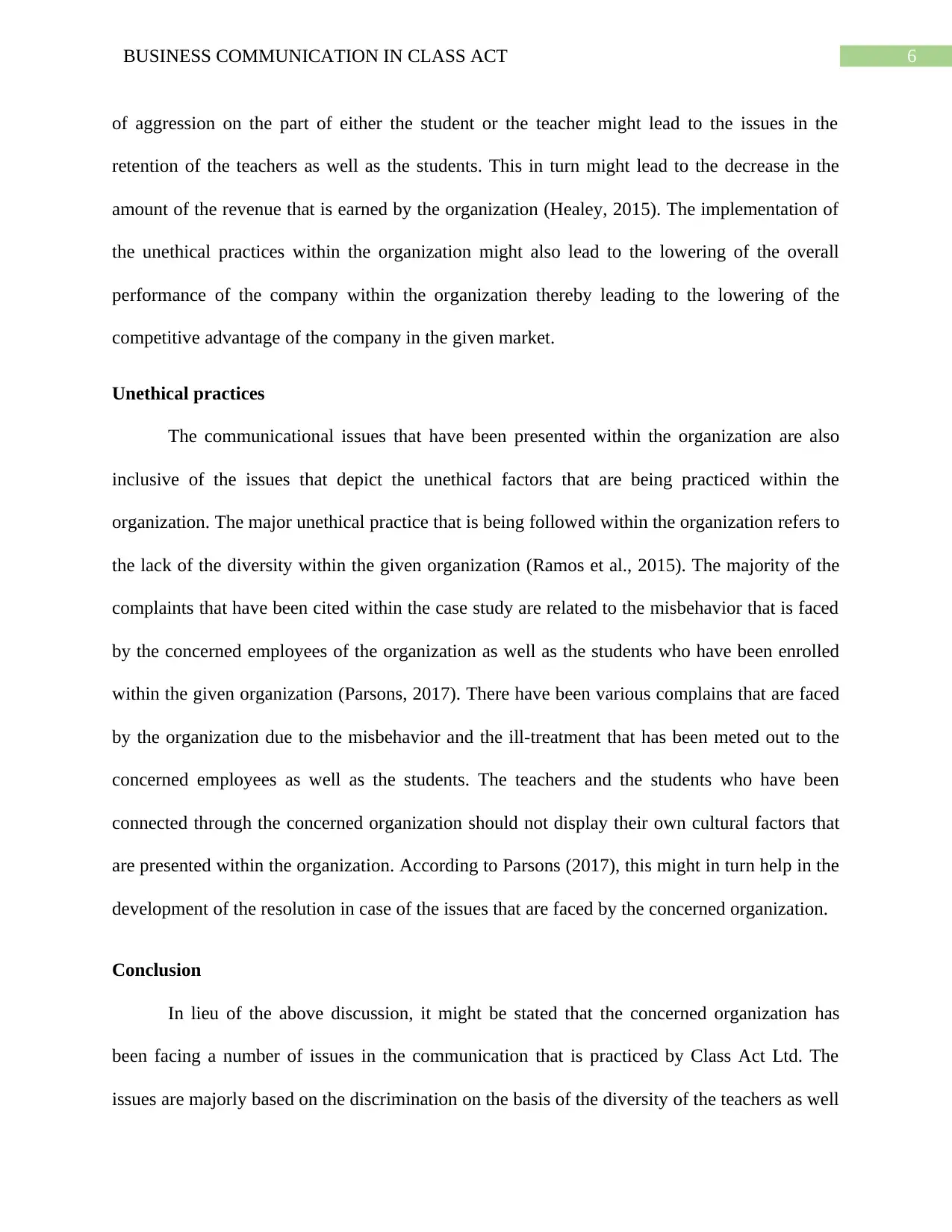
6BUSINESS COMMUNICATION IN CLASS ACT
of aggression on the part of either the student or the teacher might lead to the issues in the
retention of the teachers as well as the students. This in turn might lead to the decrease in the
amount of the revenue that is earned by the organization (Healey, 2015). The implementation of
the unethical practices within the organization might also lead to the lowering of the overall
performance of the company within the organization thereby leading to the lowering of the
competitive advantage of the company in the given market.
Unethical practices
The communicational issues that have been presented within the organization are also
inclusive of the issues that depict the unethical factors that are being practiced within the
organization. The major unethical practice that is being followed within the organization refers to
the lack of the diversity within the given organization (Ramos et al., 2015). The majority of the
complaints that have been cited within the case study are related to the misbehavior that is faced
by the concerned employees of the organization as well as the students who have been enrolled
within the given organization (Parsons, 2017). There have been various complains that are faced
by the organization due to the misbehavior and the ill-treatment that has been meted out to the
concerned employees as well as the students. The teachers and the students who have been
connected through the concerned organization should not display their own cultural factors that
are presented within the organization. According to Parsons (2017), this might in turn help in the
development of the resolution in case of the issues that are faced by the concerned organization.
Conclusion
In lieu of the above discussion, it might be stated that the concerned organization has
been facing a number of issues in the communication that is practiced by Class Act Ltd. The
issues are majorly based on the discrimination on the basis of the diversity of the teachers as well
of aggression on the part of either the student or the teacher might lead to the issues in the
retention of the teachers as well as the students. This in turn might lead to the decrease in the
amount of the revenue that is earned by the organization (Healey, 2015). The implementation of
the unethical practices within the organization might also lead to the lowering of the overall
performance of the company within the organization thereby leading to the lowering of the
competitive advantage of the company in the given market.
Unethical practices
The communicational issues that have been presented within the organization are also
inclusive of the issues that depict the unethical factors that are being practiced within the
organization. The major unethical practice that is being followed within the organization refers to
the lack of the diversity within the given organization (Ramos et al., 2015). The majority of the
complaints that have been cited within the case study are related to the misbehavior that is faced
by the concerned employees of the organization as well as the students who have been enrolled
within the given organization (Parsons, 2017). There have been various complains that are faced
by the organization due to the misbehavior and the ill-treatment that has been meted out to the
concerned employees as well as the students. The teachers and the students who have been
connected through the concerned organization should not display their own cultural factors that
are presented within the organization. According to Parsons (2017), this might in turn help in the
development of the resolution in case of the issues that are faced by the concerned organization.
Conclusion
In lieu of the above discussion, it might be stated that the concerned organization has
been facing a number of issues in the communication that is practiced by Class Act Ltd. The
issues are majorly based on the discrimination on the basis of the diversity of the teachers as well
Paraphrase This Document
Need a fresh take? Get an instant paraphrase of this document with our AI Paraphraser
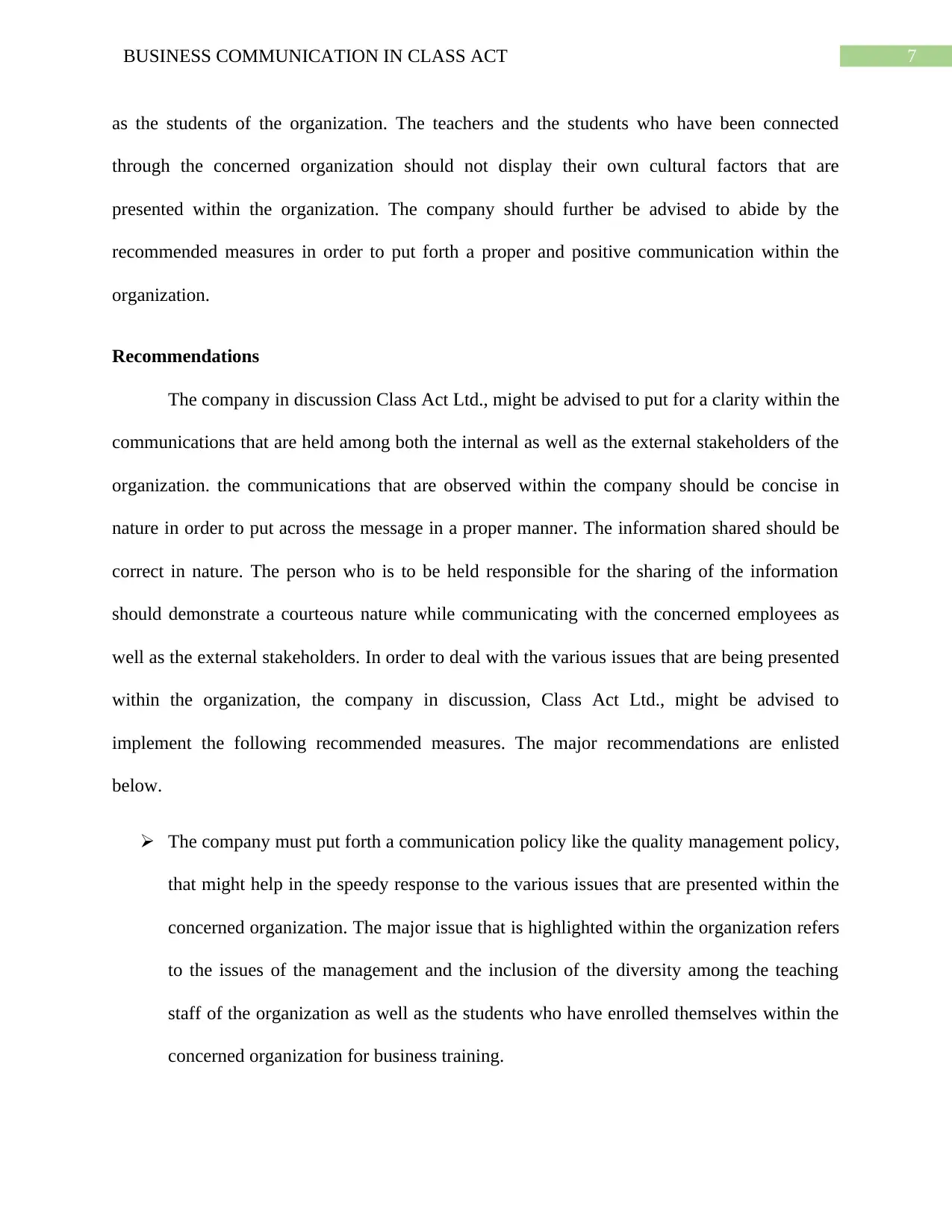
7BUSINESS COMMUNICATION IN CLASS ACT
as the students of the organization. The teachers and the students who have been connected
through the concerned organization should not display their own cultural factors that are
presented within the organization. The company should further be advised to abide by the
recommended measures in order to put forth a proper and positive communication within the
organization.
Recommendations
The company in discussion Class Act Ltd., might be advised to put for a clarity within the
communications that are held among both the internal as well as the external stakeholders of the
organization. the communications that are observed within the company should be concise in
nature in order to put across the message in a proper manner. The information shared should be
correct in nature. The person who is to be held responsible for the sharing of the information
should demonstrate a courteous nature while communicating with the concerned employees as
well as the external stakeholders. In order to deal with the various issues that are being presented
within the organization, the company in discussion, Class Act Ltd., might be advised to
implement the following recommended measures. The major recommendations are enlisted
below.
The company must put forth a communication policy like the quality management policy,
that might help in the speedy response to the various issues that are presented within the
concerned organization. The major issue that is highlighted within the organization refers
to the issues of the management and the inclusion of the diversity among the teaching
staff of the organization as well as the students who have enrolled themselves within the
concerned organization for business training.
as the students of the organization. The teachers and the students who have been connected
through the concerned organization should not display their own cultural factors that are
presented within the organization. The company should further be advised to abide by the
recommended measures in order to put forth a proper and positive communication within the
organization.
Recommendations
The company in discussion Class Act Ltd., might be advised to put for a clarity within the
communications that are held among both the internal as well as the external stakeholders of the
organization. the communications that are observed within the company should be concise in
nature in order to put across the message in a proper manner. The information shared should be
correct in nature. The person who is to be held responsible for the sharing of the information
should demonstrate a courteous nature while communicating with the concerned employees as
well as the external stakeholders. In order to deal with the various issues that are being presented
within the organization, the company in discussion, Class Act Ltd., might be advised to
implement the following recommended measures. The major recommendations are enlisted
below.
The company must put forth a communication policy like the quality management policy,
that might help in the speedy response to the various issues that are presented within the
concerned organization. The major issue that is highlighted within the organization refers
to the issues of the management and the inclusion of the diversity among the teaching
staff of the organization as well as the students who have enrolled themselves within the
concerned organization for business training.
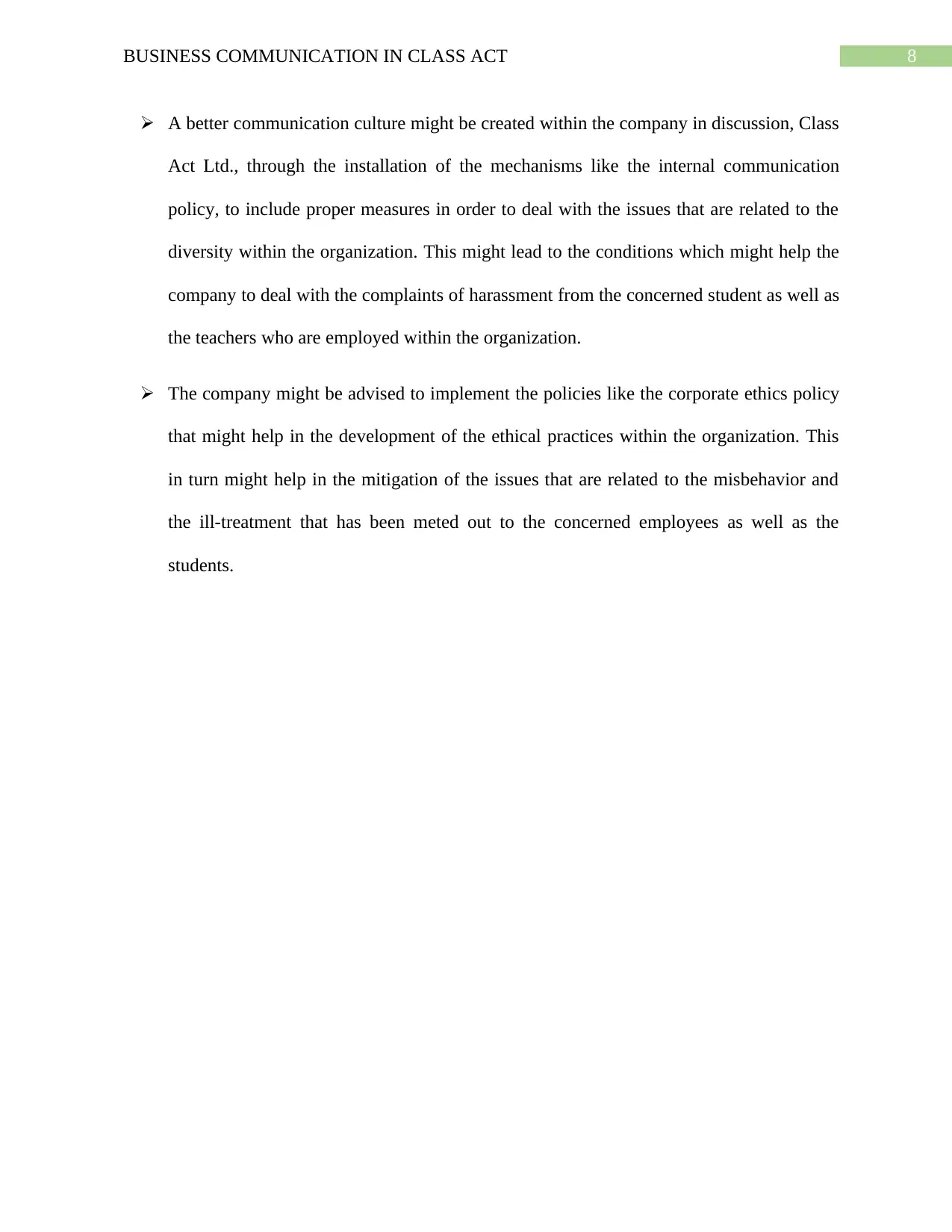
8BUSINESS COMMUNICATION IN CLASS ACT
A better communication culture might be created within the company in discussion, Class
Act Ltd., through the installation of the mechanisms like the internal communication
policy, to include proper measures in order to deal with the issues that are related to the
diversity within the organization. This might lead to the conditions which might help the
company to deal with the complaints of harassment from the concerned student as well as
the teachers who are employed within the organization.
The company might be advised to implement the policies like the corporate ethics policy
that might help in the development of the ethical practices within the organization. This
in turn might help in the mitigation of the issues that are related to the misbehavior and
the ill-treatment that has been meted out to the concerned employees as well as the
students.
A better communication culture might be created within the company in discussion, Class
Act Ltd., through the installation of the mechanisms like the internal communication
policy, to include proper measures in order to deal with the issues that are related to the
diversity within the organization. This might lead to the conditions which might help the
company to deal with the complaints of harassment from the concerned student as well as
the teachers who are employed within the organization.
The company might be advised to implement the policies like the corporate ethics policy
that might help in the development of the ethical practices within the organization. This
in turn might help in the mitigation of the issues that are related to the misbehavior and
the ill-treatment that has been meted out to the concerned employees as well as the
students.
⊘ This is a preview!⊘
Do you want full access?
Subscribe today to unlock all pages.

Trusted by 1+ million students worldwide
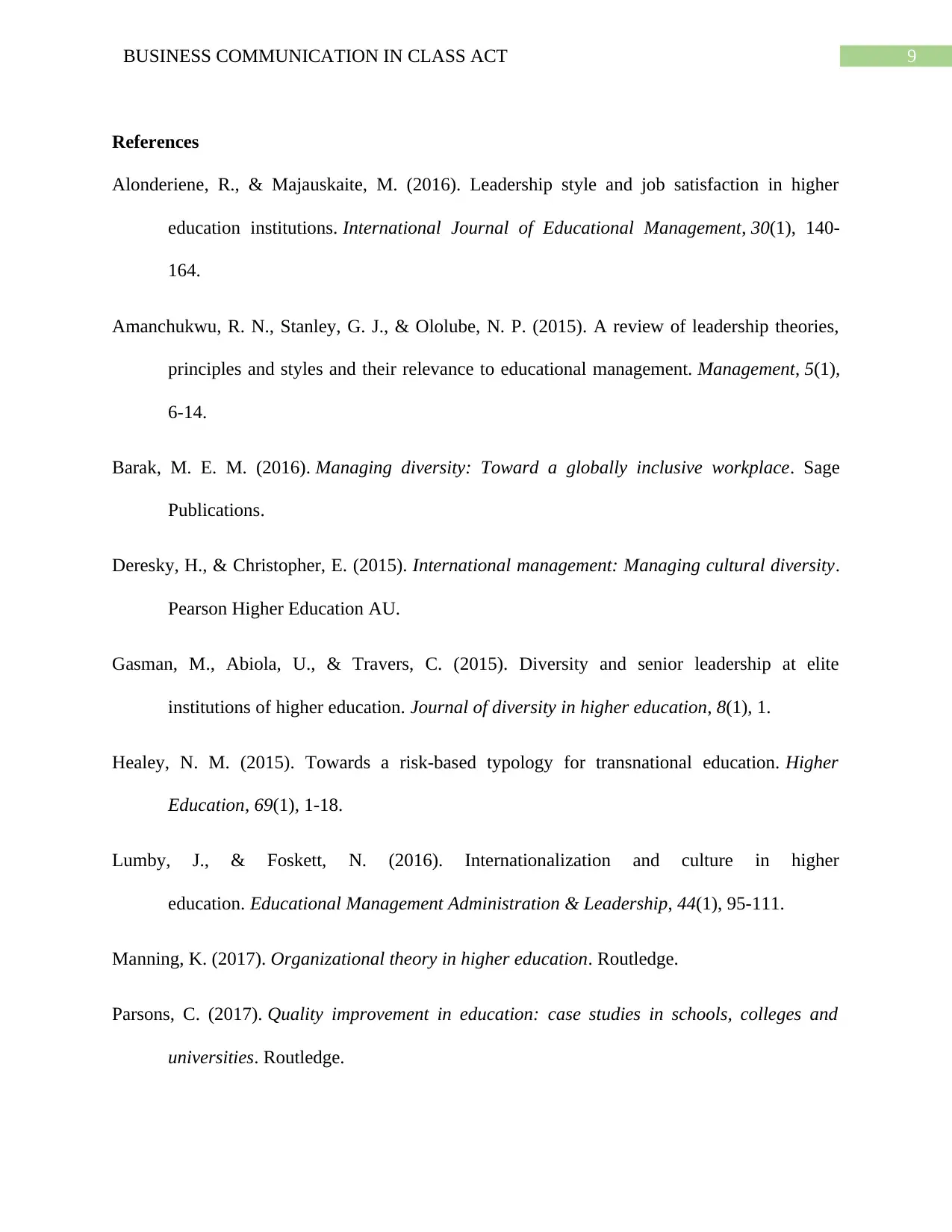
9BUSINESS COMMUNICATION IN CLASS ACT
References
Alonderiene, R., & Majauskaite, M. (2016). Leadership style and job satisfaction in higher
education institutions. International Journal of Educational Management, 30(1), 140-
164.
Amanchukwu, R. N., Stanley, G. J., & Ololube, N. P. (2015). A review of leadership theories,
principles and styles and their relevance to educational management. Management, 5(1),
6-14.
Barak, M. E. M. (2016). Managing diversity: Toward a globally inclusive workplace. Sage
Publications.
Deresky, H., & Christopher, E. (2015). International management: Managing cultural diversity.
Pearson Higher Education AU.
Gasman, M., Abiola, U., & Travers, C. (2015). Diversity and senior leadership at elite
institutions of higher education. Journal of diversity in higher education, 8(1), 1.
Healey, N. M. (2015). Towards a risk-based typology for transnational education. Higher
Education, 69(1), 1-18.
Lumby, J., & Foskett, N. (2016). Internationalization and culture in higher
education. Educational Management Administration & Leadership, 44(1), 95-111.
Manning, K. (2017). Organizational theory in higher education. Routledge.
Parsons, C. (2017). Quality improvement in education: case studies in schools, colleges and
universities. Routledge.
References
Alonderiene, R., & Majauskaite, M. (2016). Leadership style and job satisfaction in higher
education institutions. International Journal of Educational Management, 30(1), 140-
164.
Amanchukwu, R. N., Stanley, G. J., & Ololube, N. P. (2015). A review of leadership theories,
principles and styles and their relevance to educational management. Management, 5(1),
6-14.
Barak, M. E. M. (2016). Managing diversity: Toward a globally inclusive workplace. Sage
Publications.
Deresky, H., & Christopher, E. (2015). International management: Managing cultural diversity.
Pearson Higher Education AU.
Gasman, M., Abiola, U., & Travers, C. (2015). Diversity and senior leadership at elite
institutions of higher education. Journal of diversity in higher education, 8(1), 1.
Healey, N. M. (2015). Towards a risk-based typology for transnational education. Higher
Education, 69(1), 1-18.
Lumby, J., & Foskett, N. (2016). Internationalization and culture in higher
education. Educational Management Administration & Leadership, 44(1), 95-111.
Manning, K. (2017). Organizational theory in higher education. Routledge.
Parsons, C. (2017). Quality improvement in education: case studies in schools, colleges and
universities. Routledge.
Paraphrase This Document
Need a fresh take? Get an instant paraphrase of this document with our AI Paraphraser
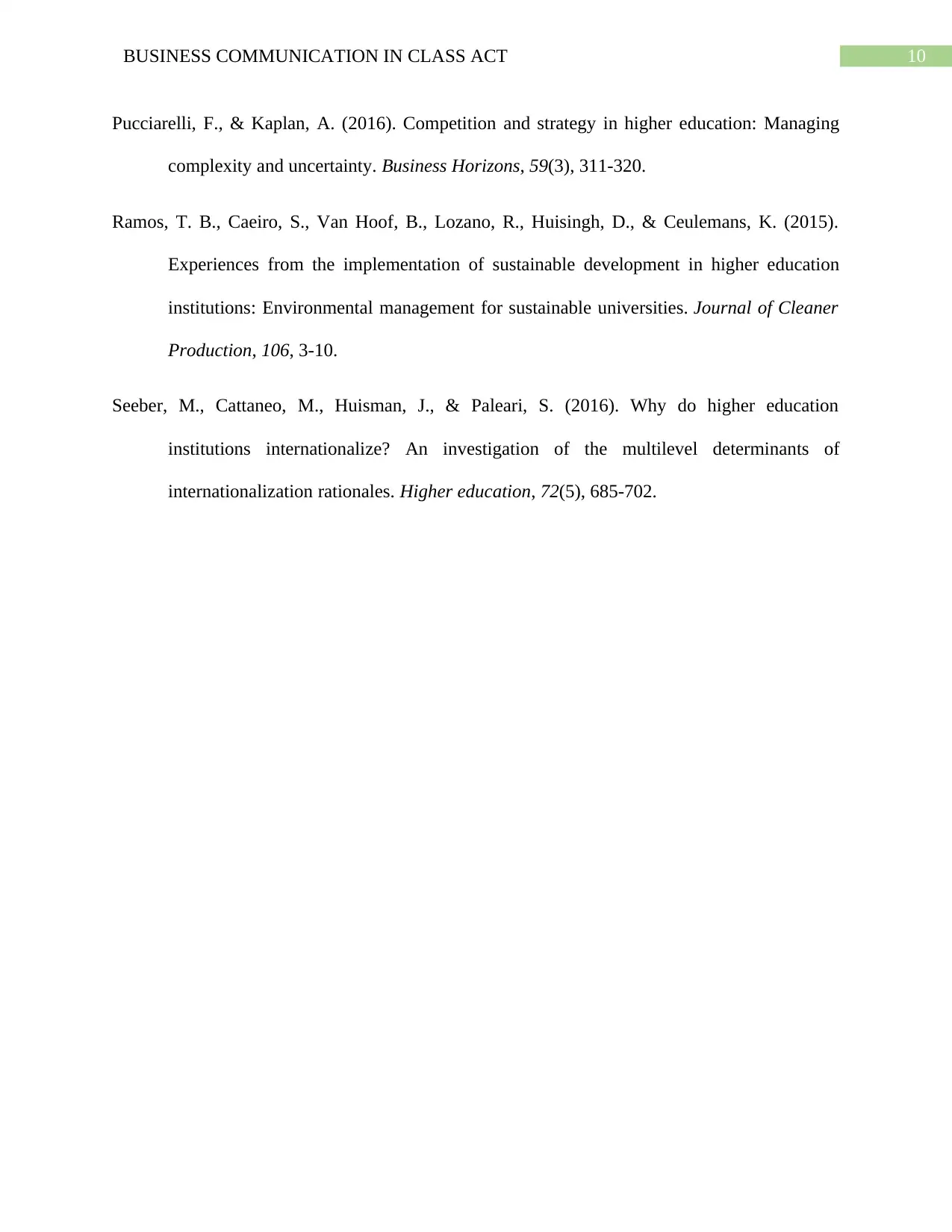
10BUSINESS COMMUNICATION IN CLASS ACT
Pucciarelli, F., & Kaplan, A. (2016). Competition and strategy in higher education: Managing
complexity and uncertainty. Business Horizons, 59(3), 311-320.
Ramos, T. B., Caeiro, S., Van Hoof, B., Lozano, R., Huisingh, D., & Ceulemans, K. (2015).
Experiences from the implementation of sustainable development in higher education
institutions: Environmental management for sustainable universities. Journal of Cleaner
Production, 106, 3-10.
Seeber, M., Cattaneo, M., Huisman, J., & Paleari, S. (2016). Why do higher education
institutions internationalize? An investigation of the multilevel determinants of
internationalization rationales. Higher education, 72(5), 685-702.
Pucciarelli, F., & Kaplan, A. (2016). Competition and strategy in higher education: Managing
complexity and uncertainty. Business Horizons, 59(3), 311-320.
Ramos, T. B., Caeiro, S., Van Hoof, B., Lozano, R., Huisingh, D., & Ceulemans, K. (2015).
Experiences from the implementation of sustainable development in higher education
institutions: Environmental management for sustainable universities. Journal of Cleaner
Production, 106, 3-10.
Seeber, M., Cattaneo, M., Huisman, J., & Paleari, S. (2016). Why do higher education
institutions internationalize? An investigation of the multilevel determinants of
internationalization rationales. Higher education, 72(5), 685-702.
1 out of 11
Related Documents
Your All-in-One AI-Powered Toolkit for Academic Success.
+13062052269
info@desklib.com
Available 24*7 on WhatsApp / Email
![[object Object]](/_next/static/media/star-bottom.7253800d.svg)
Unlock your academic potential
Copyright © 2020–2025 A2Z Services. All Rights Reserved. Developed and managed by ZUCOL.





